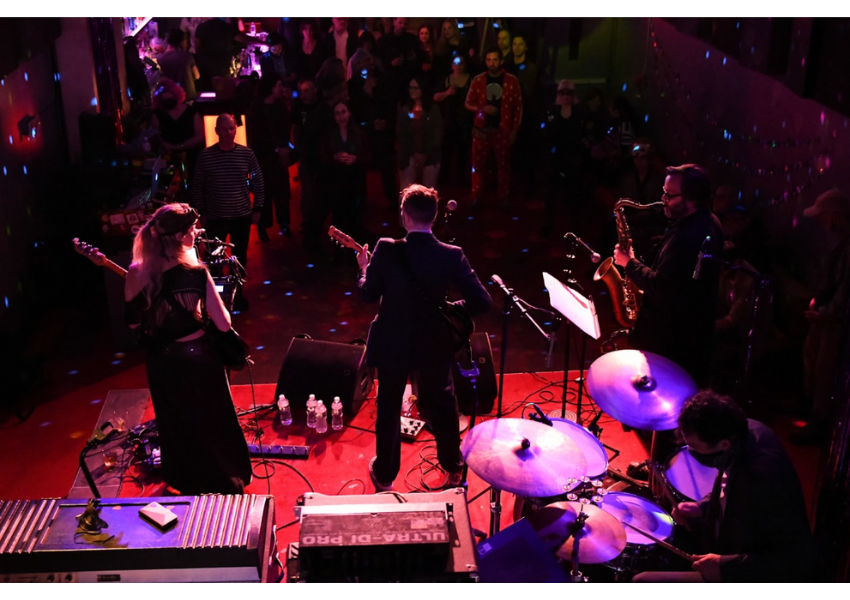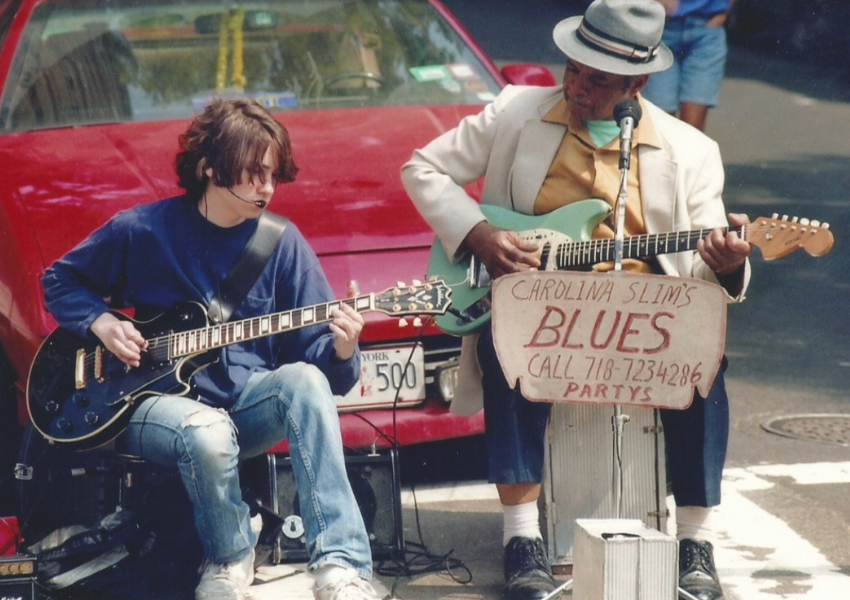The Sway Machinery: Between Ritual and Rock Show
Published Sep 27, 2022

The Sway Machinery: The Beginning (Part 1/8)

The Sway Machinery is a rock band that I have led for the past 15 years. The band was founded out of a deep urge I felt to explore my family’s cantorial legacy. My grandfather, Jacob Konigsberg, was a well-known cantor. I grew up revering his khazones and respecting his authority as a source of knowledge about music and the spirit. My family’s music was not my only musical passion.
The Sway Machinery (Part 2/8)

Above: The author pictured at age 14 with Carolina Slim playing on the streets of Manhattan.
At an early age I became obsessed with old blues records and began playing the guitar. From the age of 14 I was playing with an elder blues musician, Carolina Slim, aka Elijah Staley. I accompanied Staley and studied the Piedmont blues tradition he represented for decades. I conceived The Sway Machinery as a world of memory and experimentation, where I could delve deeply into the musical world of old cantorial sound, from the particular vantage point of my musical knowledge and position in history.
In this long running project, I have focused my energies on the music of gramophone era “golden age” cantors whose work was both a form of sacred experience and a style tailored to the technologies of recorded sound. The band’s music draws on this history of music that is propelled by the form and energy of ritual, rarified aesthetics, and a concern with machinery, noise and the propulsive energies of post-industrial urban life. The cantors who I take as my sources of inspiration, such as Zawel Kwartin, Pierre Pinchik, and Leib Glantz, were intellectuals and creative artists who called upon sounds of the past, even as their work transformed tradition to create highly dramatic, formally complex and emotionally sophisticated theatrical versions of Jewish ritual on record.
The Sway Machinery (Part 3/8)

Above: The Sway Machinery in 2006. From the left: Jordan McLean, Stuart Bogie, Jeremiah Lockwood, Colin Stetson and Tomer Tzur.
The Sway Machinery (Part 4/8)
Above: A clip from Hidden Melodies Revealed in 2007.
The Sway Machinery has operated as a collective with a core group of musicians who have been central to crafting our unique sound. Saxophonist Stuart Bogie and trumpeter Jordan McLean, both associated with the band Antibalas, lent a hard-hitting vitality to the band. Their presence encouraged me to develop as a composer, writing arrangements that leaned on their skills as performers in afrobeat and neo-soul. Bass saxophonist Colin Stetson brought an unbelievable stamina and physicality to the band, performing complex and rhythmically supple bass lines on the saxophone. When founding member Tomer Tzur moved back to his native Israel shortly after the band started working steadily, we were joined by Brian Chase, drummer of the beloved NYC rock band Yeah Yeah Yeahs. This was the lineup that performed on The Sway Machinery’s breakout project, Hidden Melodies Revealed.
The Sway Machinery (Part 5/8)
Above: Hidden Melodies Revealed was the concept for our first album released on JDub records in 2009.
Conceived as a radical revision of the Rosh Hashana liturgy, Hidden Melodies Revealed premiered on the first night of the Jewish new year in 2007 at the Angel Orensanz Foundation, a historical Jewish synagogue where my grandfather had performed his debut concert in 1949.
The Sway Machinery (Part 6/8)
Above: Gawad Teriamou from our 2011 album The House of Friendly Ghosts Vol. 1, featuring Khaira Arby.
The band’s next major project was conceived as an exploration of the pan-diasporic principles that undergirded the music. The band received an invitation to perform at the Festival of the Desert in Timbuktu, Mali in 2010. For this trip, the band was joined by the brilliant drummer John Bollinger, who I had first played with as a teenager. I thought of our trip as a pilgrimage to one of the sacred sites of international musical culture. Through this undertaking I hoped to pay homage to the memory of my grandfather, who had recently passed away, by being the first group presenting any aspect of Jewish culture in this Muslim African milieu. The music of the Sahara was a touchstone for many of the pieces I had written for the band. Connecting to worlds of sound through travel and collaboration with local musicians was a profound experience. While in Mali, we collaborated with Timbuktu-based vocalist Khaira Arby (of blessed memory) and recorded an album with her.
The Sway Machinery (Part 7/8)
Above: Pierre Pinchik’s “Rozo D’shabbos”, from our 2015 release Purity and Danger.
In the decade since, we have performed on four continents, made more records and expanded the collective to include artists including saxophonist Matt Bauder, bass player Nikhil Yerawadekar, and guitarist Timothy Allen.
The Sway Machinery (Part 8/8)
Above: Recent performance from The Sway Machinery of “Mageyn Avos”, featuring Yuli Yael Be’eri.
The years of the pandemic brought the band to an unnatural quiet. In 2022 we have begun to perform together again and are beginning work on a new record. Towards this goal, the band has recently been joined by our old friend singer and bass player, Yuli Yael Be’eri. We are currently rebuilding towards the utopian future we dreamed of, in which ritual and performance join together and the voice of artists guide the spirit life of the community.
Top Tracks from The Sway Machinery
Take a listen!
Jeremiah Lockwood is a scholar and musician, working in the fields of Jewish studies, performance studies, and ethnomusicology.
Reflections
Go deeper
Is listening to music a sacred act?
Think about it
What role do the senses play in Jewish sacred experience?
Make a list
What kinds of sounds can initiate spiritual experience?
Want more?
Get curated JewishArts.org content in your inbox


